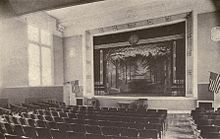
The Auditorium Building in Chicago is one of the best-known designs of Louis Sullivan and Dankmar Adler. Completed in 1889, the building is located at the northwest corner of South Michigan Avenue and Ida B. Wells Drive. The building was designed to be a multi-use complex, including offices, a theater, and a hotel. As a young apprentice, Frank Lloyd Wright worked on some of the interior design.
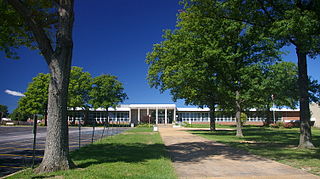
Affton High School is a public comprehensive high school in Affton, St. Louis County, Missouri that is part of the Affton School District.

The Edwin C. Denby High School is a public secondary education school located at 12800 Kelly Road in northeastern Detroit, Michigan. Denby High opened in 1930, and the building was listed on the National Register of Historic Places in 2005. It is a part of Detroit Public Schools Community District.

Ogden High School is an Art Deco secondary school located in Ogden, Utah, educating students in grades 10–12. Operated by the Ogden City School District, Ogden High enrolls approximately 1,250 students each year. The graduation rate has increased dramatically over the past three years. The school houses an International Baccalaureate Programme, a Project Lead the Way program and a thriving Life Sciences/Pre-Med program. OHS also offers a dozen AP classes and the AVID program. Ogden High has most recently earned state championships in both marching band and girls soccer. Both teams won state championships in 2019 and 2021. The Ogden High mascot is the Tiger. In 2012, Ogden High School began offering International Baccalaureate courses and in 2014 graduated the first IB Diploma Programme class.

Crispus Attucks High School is a public high school of Indianapolis Public Schools in Indianapolis, Indiana, U.S. Its namesake, Crispus Attucks, was an African American patriot killed during the Boston Massacre. The school was built northwest of downtown Indianapolis near Indiana Avenue and opened on September 12, 1927, when it was the only public high school in the city designated specifically for African Americans.

El Paso High School is the oldest operating high school in El Paso, Texas, and is part of the El Paso Independent School District. It serves the west-central section of the city, roughly south and west of the Franklin Mountains and north of Interstate 10 to the vicinity of Executive Center Boulevard. It is fed by Wiggs Middle School, into which the three elementary schools in its feeder pattern, Lamar, Mesita, and Vilas, graduate.
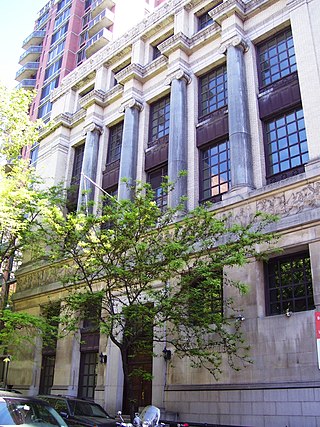
The New York School of Applied Design for Women, established in 1892 by Ellen Dunlap Hopkins, was an early design school for women in New York City. The 1908 New York School of Applied Design building was designed by Harvey Wiley Corbett and is now landmarked.

Horace Howard Furness High School is a secondary (9th-12th) school in South Philadelphia. It is part of the School District of Philadelphia.
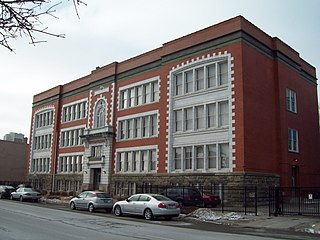
School 13, also known as Boys Vocational High School and Buffalo Alternative High School, is a historic school building located at Buffalo in Erie County, New York. It was built about 1915, and is a three-story, steel framed building sheathed in brick and terra cotta with Beaux-Arts style design elements. The T-shaped building housed administrative offices, classrooms, a gymnasium, swimming pool, and two-story auditorium. The building housed a school until 2003.

The Sacramento Masonic Temple, built between 1913 and 1918, is a five-story building on J Street in downtown Sacramento, California. The building was listed on the National Register of Historic Places in 2001.

The former Washington School is located on Croton Avenue in the village of Ossining, New York, United States. It was built in 1907 in the Beaux-Arts style, one of two in the village to use it. It was added to the National Register of Historic Places in 1987.

Fort Armstrong Theatre, is an historic building located in downtown Rock Island, Illinois, United States. It opened in 1920 and it was individually listed on the National Register of Historic Places in 1980. In 2020 it was included as a contributing property in the Downtown Rock Island Historic District. It was commonly referred to as the Fort Theater. The theater was named for Fort Armstrong, a fortification that sat in the middle of the Mississippi River near the present location of the Rock Island Arsenal.

Bala Cynwyd Junior High School Complex, is a historic school complex in Bala Cynwyd, Pennsylvania. The complex includes the 'Bala Cynwyd Middle School, the Cynwyd Elementary School, and the former Lower Merion Academy. The elementary school and middle schools are part of the Lower Merion School District.
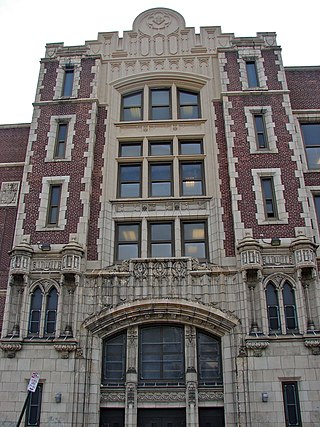
The John L. Kinsey School is a former K-8 school that is located in the West Oak Lane neighborhood of Philadelphia, Pennsylvania. It was a part of the School District of Philadelphia.

Murrell Dobbins Career & Technical Education High School, also known as Murrell Dobbins Vocational High School, is a historic vocational school building located in the West Lehigh neighborhood of North Philadelphia, Pennsylvania, United States. It is part of the School District of Philadelphia. The building was designed by Irwin T. Catharine and built between 1936–1937. It is a six- to seven-story, 14-bay, brick building in the Moderne-style. It has a one-story, stone front building. It features brick piers with terracotta tops and the building has terra cotta trim.

Edwin Forrest School is a public elementary school located in the Mayfair neighborhood of Philadelphia, Pennsylvania. It is within the School District of Philadelphia.

Ethan Allen School is a K–8 school which is located in the Mayfair neighborhood of Philadelphia, Pennsylvania. It is part of the School District of Philadelphia.
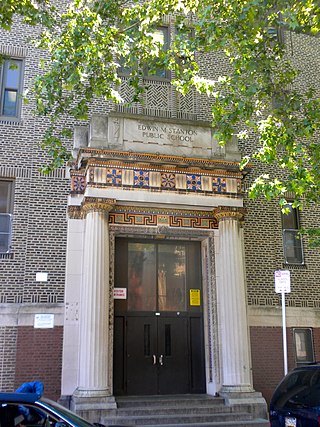
Edwin M. Stanton School is an historic K-8 school located in the Southwest Center City neighborhood of Philadelphia, Pennsylvania, within the Christian Street Historic District. It is part of the School District of Philadelphia.

The old Belvidere High School is a complex of four connected buildings that reflect three different architectural styles: Classical Revival, Prairie School, and Art Deco. It is composed of the 1893 Garfield School, a 1900 powerhouse, the 1916 Belvidere High School, and the 1939 Belvidere High School Auditorium & Gymnasium.

University Junior High School is a historic former secondary school on the University of Texas at Austin campus in Austin, Texas. Opened in 1933 as a joint project between the university and the Austin Independent School District, the school served both as a public junior high school and as a laboratory school for the university's Department of Education until 1967, when the school was closed and the facility turned over to UT. Today, the building houses the university's School of Social Work and its Child Care Center. The school was added to the National Register of Historic Places in 2001.





